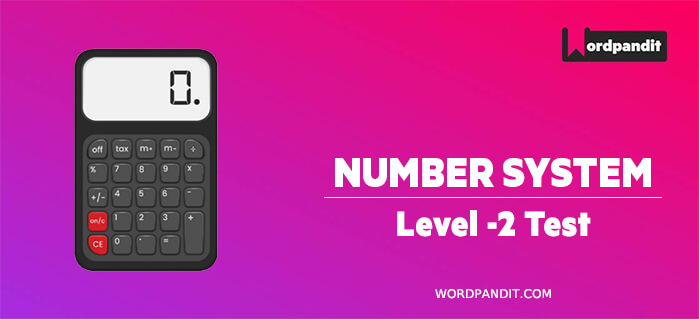- This is an assessment test.
- To draw maximum benefit, study the concepts for the topic concerned.
- Kindly take the tests in this series with a pre-defined schedule.
Number System: Level 2 Test -5
Congratulations - you have completed Number System: Level 2 Test -5.You scored %%SCORE%% out of %%TOTAL%%.You correct answer percentage: %%PERCENTAGE%% .Your performance has been rated as %%RATING%%
Your answers are highlighted below.
Question 1 |
For the product n(n + 1)(2n + 1), n being a natural number, which one of the following is not necessarily true?
It is even | |
Divisible by 3 | |
Divisible by the sum of the square of first n natural numbers | |
Never divisible by 237 |
Question 1 Explanation:
We can use this question by solving options.
Have a look at the options:
Option 4 says that the number is never divisible by 237, and for for n = 237, the expression n(n + 1) (2n + 1) becomes divisible by 237, which is not necessarily true, thus the fourth option is the answer.
Question 2 |
An intelligence agency decides on a code of 2 digits selected from 0, 1, 2, …. , 9. But the slip on which the code is hand–written allows confusion between top and bottom, because these are indistinguishable. Thus, for example, the code 91 could be confused with 16. How many codes are there such that there is no possibility of any confusion?
25 | |
75 | |
80 | |
None of these |
Question 2 Explanation:
Let us watch something the number of codes can be formed is 10 × 10= 100, the number which can create confusions are 0,1,6,8,9. Now these five digits can make 25 digits but there is an another problem there are some codes among these numbers which cannot make confusions
The numbers 00,11,88,69 and 96 will not make any confusion. Hence answer is 100 – 25 + 5 =80.
Question 3 |
To decide whether a number of n digits is divisible by 7, we can define a process by which its magnitude is reduced as follows: (i1, i2, i3, … , are the digits of the number, starting from the most significant digit). i1 i2 ……. in ⇒ i1. 3n-1 +i2 . 3n-2 + ……… + in 30. For e.g. 259 ⇒ 2.32 + 5.31 + 9.30 = 18 + 15 + 9 = 42. Ultimately the resulting number will be seven after repeating the above process a certain number of times. After how many such stages, does the number 203 reduce to 7?
2 | |
3. | |
4 | |
1 |
Question 3 Explanation:
203 = 2.3 + 0.31 + 3.32 = 18 + 0 + 1 = 21 ,
21 = 2.31 + 1.30 = 6 + 1 = 7.
Therefore we can reduce 203 to 7 in 2 steps.
21 = 2.31 + 1.30 = 6 + 1 = 7.
Therefore we can reduce 203 to 7 in 2 steps.
Question 4 |
Five-digit numbers can be formed using digits 0, 1, 2, 3, 4 exactly once. What is the difference between the maximum and minimum number that can be formed by using these digits?
19800 | |
41976 | |
32976 | |
None of these |
Question 4 Explanation:
The maximum and the minimum five-digit numbers that can be formed using only 0, 1, 2, 3, 4 exactly once are43210 and 10234 respectively. The difference between them is 43210 – 10234 = 32976
Question 5 |
Three consecutive positive integers are raised to the first, second and third powers respectively and then added. The sum so obtained is perfect square whose square root equals the total of the three original integers. Which of the following best describes the minimum, say m, of these three integers?
1≤ m ≤ 3 | |
4 ≤ m ≤ 6 | |
7 ≤ m ≤ 9 | |
10 ≤ m ≤ 12 |
Question 5 Explanation:
Let the three consecutive positive integers be equal to ‘n – 1’, ‘n’ and ‘n + 1’.
⇒ n −1+ n^2 + (n + 1)^3 = (3n)^2 so n^3 + 4n^2+ 4n= 9n^2 n^2- 5n+ 4= 0
∴n = 1 or n = 4 since, the three integers are positive,
the value of ‘n’ cannot be equal to 1,
therefore the value of ‘n’ = 4 or m = n – 1 = 3.
Hence, the three consecutive positive integers are 3, 4 and 5.
⇒ n −1+ n^2 + (n + 1)^3 = (3n)^2 so n^3 + 4n^2+ 4n= 9n^2 n^2- 5n+ 4= 0
∴n = 1 or n = 4 since, the three integers are positive,
the value of ‘n’ cannot be equal to 1,
therefore the value of ‘n’ = 4 or m = n – 1 = 3.
Hence, the three consecutive positive integers are 3, 4 and 5.
Once you are finished, click the button below. Any items you have not completed will be marked incorrect.
There are 5 questions to complete.
List |











